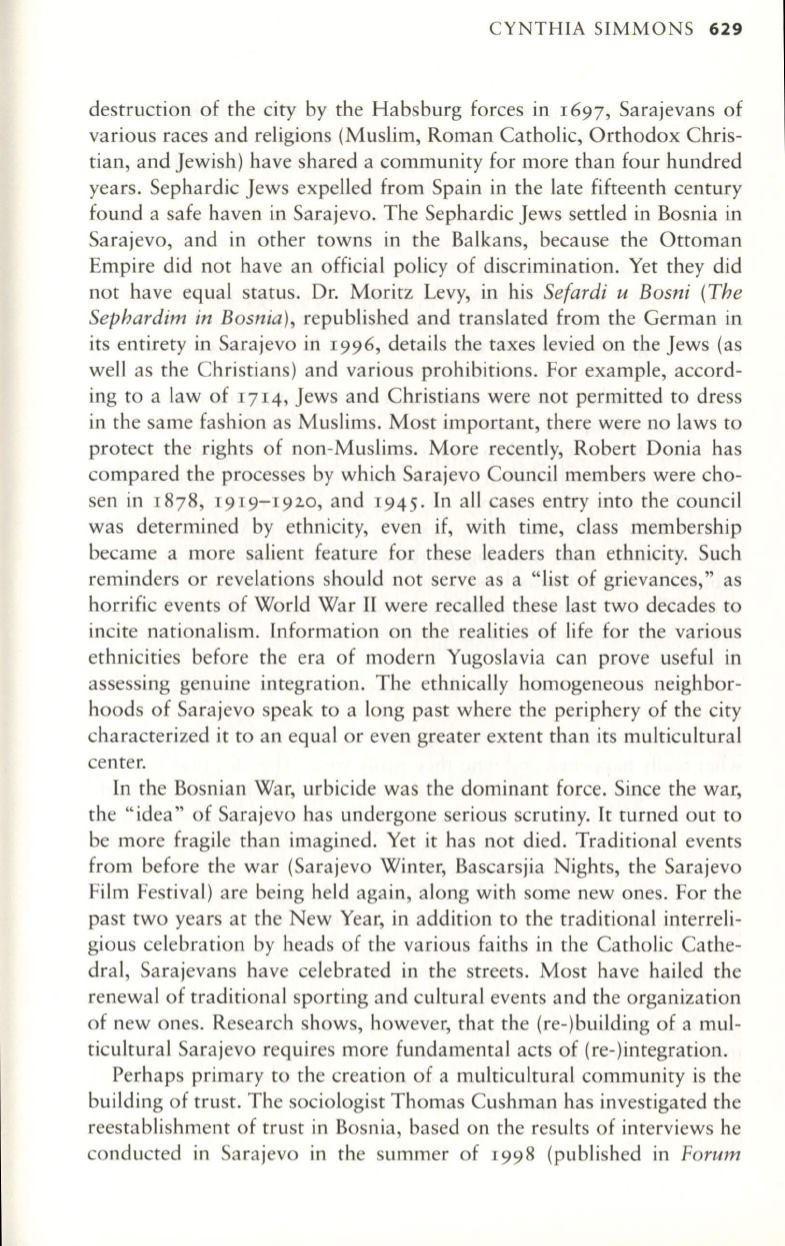
CYNTHIA SIMMONS
629
destruction of the city by the Habsburg forces in
1697,
Sarajevans of
various races and religions (Muslim, Roman Catholic, Orthodox Chris–
tian, and Jewish) have shared a community for more than four hundred
years. Sephardic Jews expelled from Spain in the late fifteenth century
found a safe haven in Sarajevo. The Sephardic Jews settled in Bosnia in
Sarajevo, and in other towns in the Balkans, because the Ottoman
Empire did not have an official policy of discrimination. Yet they did
not have equal status. Dr. Moritz Levy, in his
Sefardi u Bosni (The
Sephardim in Bosnia),
republished and translated from the German in
its entirety in Sarajevo in
1996,
details the taxes levied on the Jews (as
well as the Christians) and various prohibitions. For example, accord–
ing to a law of 1714, Jews and Christians were not permitted to dress
in the same fashion as Muslims. Most important, there were no laws
to
protect the rights of non-Muslims. More recently, Robert Donia has
compared the processes by which Sarajevo Council members were cho–
sen in
1878, 1919-1920,
and
1945.
In
all cases entry into the council
was determined by ethnicity, even if, with time, class membership
became a more salient feature for these leaders than ethnicity. Such
reminders or revelations should not serve as a "list of grievances," as
horrific events of World War II were recalled these last two decades
to
incite nationalism. Information on the realities of life for the various
ethnicities before the era of modern Yugoslavia can prove useful in
assessing genuine integration. The ethnically homogeneous neighbor–
hoods of Sarajevo speak to a long past where the periphery of the city
characterized it to an equal or even greater extent than its multicultural
center.
In
the Bosnian War, urbicide was the dominant force. Since the war,
the "idea" of Sarajevo has undergone serious scrutiny.
It
turned out to
be more fragile than imagined. Yet it has not died. Traditional events
from before the war (Sarajevo Winter, Bascarsjia Nights, the Sarajevo
Film Festival) are being held again, along with some new ones. For the
past two years at the New Year, in addition
to
the traditional interreli–
gious celebration by heads of the various faiths in the Catholic Cathe–
dral, Sarajevans have celebrated in the streets. Most have hailed the
renewal of traditional sporting and cultural events and the organization
of new ones. Research shows, however, that the (re-)building of a mul–
ticultural Sarajevo requires more fundamental acts of (re- )integration.
Perhaps primary to the creation of a multicultural community is the
building of trust. The sociologist Thomas Cushman has investigated the
reestablishment of trust in Bosnia, based on the results of interviews he
conducted in Sarajevo in the summer of
1998
(published in
Forum


